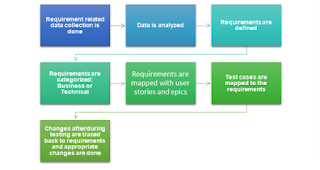Requirements traceability is the ability to describe and follow the life of a business/technical requirement in both, forward and backward, directions (i.e., from its origins, through its development and specification, to its subsequent deployment and use, and through periods of ongoing refinement and iteration in any of these phases) — Source Wikipedia
Requirements traceability provides a context to the development team and sets expectations & goals for the testing team.
Requirements tracing is bi-directional.
- Forward tracing: Requirements are traced forward to test cases, test execution, and test results
- Back tracing: Features/functions are traced back to their source, typically a business requirement
What is the need for Requirements traceability?
WhyDescriptionTo ensure compliance
All specified requirements have been met and final deliverables can be traced back to a business need. It also makes sure that every requirement is accounted for.
Helpful in analysis and design Requirements traceability ensures that each business need has been translated to a requirement, which further transforms into technical specifications, and then resulting in a deliverable.
Change impact analysisIn case of any requirement changes, traceability helps in finding the affected workflow, design, and impacted test cases.
Ensures comprehensive test coverage Requirement traceability ensures that the right test cases, which are mapped to the requirement under test, are executed. This further improves the test coverage since all the test cases are accounted for.
Helps in optimizing the testing processNot all test cases that have been generated need to be executed in case there are any changes. Traceability aids in identifying impacted parts and relevant test cases can then be executed, thus resulting in an optimal test process.
Aids in keeping track of project progressAnalysis of the requirements and the test results, and tracing it back to origins, helps in keeping track of how far the project has progressed. It also helps in keeping tabs on reality check whether the timelines will be practically met or not.
Decision making and analysisAny changes in the business need have a direct impact on requirements, which further propagates to the development and testing process. Requirement traceability helps in isolating the impacted requirements, thus identifying and updating the test cases associated with them. It makes it easier for the teams to analyze the impact of the change across the board.
Faster time to market Requirements traceability accelerates the overall development process, thus speeding up the release cycles. The number of defects is inversely proportional to requirements traceability. As the traceability increases, the defect rate goes down, simply because it becomes easier for the development team to understand and relate, and for the testing team to understand the context and scope of testing.
Increased customer confidence Requirements traceability helps in gaining and maintaining customer’s trust and confidence by increased transparency. Customers can be assured in the knowledge that all their business needs have been accounted for and are traceable to a fully functional and high-quality end product
What is a typical Requirements traceability life cycle?
What is the Requirements Traceability Matrix?
Contents of a typical RTM are
Requirements Traceability in DevOps and its challenges
It is quite evident from the previous sections that requirements tracing has a plethora of benefits, but does it work perfectly in the DevOps scenario?
In agile environments, keeping track of the requirements for every sprint and release can be a herculean task since the requirements keep evolving. One may tend to think whether all these efforts are worth it, without compromising on the release timeline and overall quality.
Two common challenges faced while striving for end-to-end requirements traceability are collaboration and maintenance.
Collaboration: Many cross-functional teams are involved when it comes to development and testing in DevOps. It calls for better collaboration for ensuring that all the requirements are effectively realized, without compromising on quality. Requirements keep evolving with every sprint and keeping traceability up to date in synchronization with various teams is a daunting task.
Maintenance: With the frequent changes of software artifacts in a DevOps environment, managing traceability for those artifacts consistently throughout the software development is extremely difficult. Therefore, traceability maintenance to cope with the continuous artifact changes becomes tough. The next section will explore how the benefits of traceability can be integrated into DevOps to handle the above-mentioned issues in order to maximize the benefits.
Requirements Traceability Matrix is a testing artifact that keeps track of all the user requirements and the details of the test cases mapped to each of those requirements. It serves as a documented proof that all the requirements have been accounted for and validated to achieve their end purpose.
Click on this link to read more Requirements Traceability Matrix
#apitestingservices #apiloadtesting #apiautomationtestingservices #Agile, #Automation, #DevOps, #Requirement traceability Matrix, #RTM





